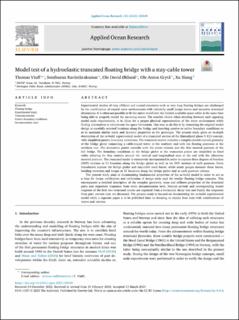| dc.contributor.author | Hansen Viuff, Thomas | |
| dc.contributor.author | Ravinthrakumar, Senthuran | |
| dc.contributor.author | Økland, Ole David | |
| dc.contributor.author | Grytå, Ole Anton | |
| dc.contributor.author | Xiang, Xu | |
| dc.date.accessioned | 2023-06-21T07:44:08Z | |
| dc.date.available | 2023-06-21T07:44:08Z | |
| dc.date.created | 2023-06-20T11:03:28Z | |
| dc.date.issued | 2023 | |
| dc.identifier.issn | 0141-1187 | |
| dc.identifier.uri | https://hdl.handle.net/11250/3072405 | |
| dc.description.abstract | Experimental studies of long offshore and coastal structures such as very long floating bridges are challenged by the combination of coastal wave environments with relatively small design waves and excessive structural dimensions. It is often not possible to fit the entire model into the limited available space while at the same time being able to properly model the incoming waves. The sensible choice when deciding between such opposing model scale requirements, is to allow for a proper physical representation of the wave environment while finding alternatives to circumvent the space limitations. One way to do this is by truncating the original model design at carefully selected locations along the bridge and inserting passive or active boundary conditions so as to maintain similar static and dynamic properties as the prototype. The present study gives an in-depth description of the as-build experimental model of a truncated section of the Bjørnafjord phase 5 K12 concept, with simplified passive boundary conditions. The truncated section includes a complex double-curved geometry of the bridge girder connecting a cable-stayed tower at the southern end with ten floating pontoons at the northern end. The truncation points coincide with the tower column and the first moored pontoon of the full bridge. The boundary conditions in the bridge girder at the truncation points are simplified as fixed while allowing for free rotation around the vertical and longitudinal axes at the end with the otherwise moored pontoon. The truncated model is extensively instrumented in order to capture three degrees of freedom (DOF) motions at 13 locations along the bridge girder as well as six DOF motions of each pontoon. Force transducers capture the bridge girder and stay-cable axial forces, while strain gauges measure shear forces, bending moments and torque at 12 locations along the bridge girder and at each pontoon column.
The present study aims at documenting fundamental properties of the as-build model in order to act as a base for future verification and calibration of design tools used for similar floating bridge concepts. This encompasses a detailed description of the complex geometry, mass and stiffness properties of the structural parts and important responses from static documentation tests. Natural periods and corresponding modal response of the first two structural modes are captured from a horizontal decay test and finally the responses from pure current tests are discussed. The present study is focused on documenting the as-build experimental model while a separate paper is to be published later on focusing on results from tests with combinations of waves and current. | en_US |
| dc.language.iso | eng | en_US |
| dc.publisher | Elsevier | en_US |
| dc.rights | Navngivelse 4.0 Internasjonal | * |
| dc.rights.uri | http://creativecommons.org/licenses/by/4.0/deed.no | * |
| dc.subject | Floating bridge | en_US |
| dc.subject | Experimental study | en_US |
| dc.subject | Truncated model | en_US |
| dc.subject | Passive boundary conditions | en_US |
| dc.subject | Documentation tests | en_US |
| dc.title | Model test of a hydroelastic truncated floating bridge with a stay-cable tower | en_US |
| dc.title.alternative | Model test of a hydroelastic truncated floating bridge with a stay-cable tower | en_US |
| dc.type | Journal article | en_US |
| dc.type | Peer reviewed | en_US |
| dc.description.version | publishedVersion | en_US |
| dc.rights.holder | © 2023 The Author(s). Published by Elsevier Ltd. This is an open access article under the CC BY license (http://creativecommons.org/licenses/by/4.0/). | en_US |
| dc.source.volume | 135 | en_US |
| dc.source.journal | Applied Ocean Research | en_US |
| dc.identifier.doi | 10.1016/j.apor.2023.103539 | |
| dc.identifier.cristin | 2156118 | |
| dc.source.articlenumber | 103539 | en_US |
| cristin.ispublished | true | |
| cristin.fulltext | original | |
| cristin.qualitycode | 1 | |

